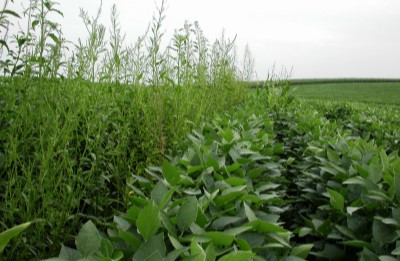 Waterhemp in soybean field (GROWMARK, Inc.)
Waterhemp in soybean field (GROWMARK, Inc.)
- Seed production of waterhemp is very difficult to reduce with harvest aid herbicides.
- Consider resistance profile in waterhemp populations when choosing chemistries for pre-harvest herbicide applications.
- Schedule harvest aid herbicide applications on the basis of crop maturity, not weed maturity.
Many corn and soybean fields have weed escapes or weeds that were left uncontrolled after postemergence herbicide applications. Preharvest herbicide applications may be used in some fields to limit weeds at harvest. In some cases, preharvest herbicide applications may limit production of weed seeds; however, it is too late to reduce seed production for most weed species.
Why do preharvest herbicides not impact seed production of many weed species? Many weeds will flower before maturity of the crop and are capable of producing mature, viable seed, even when the weeds are killed before harvest. For example, research with late applications of 2,4-D on corn found that late season applications were more effective at reducing seed production in cocklebur than in velvetleaf. Cocklebur flowers later in the season, so 2,4-D application results in greater limitation of production of viable seed. Velvetleaf flowers over a longer period than cocklebur, so preharvest 2,4-D application allows for some viable seed to be produced. Effective preharvest weed control requires that we identify the weed and determine the stage of weed growth, to estimate the level of weed seed produced at the time of application.
One of the most troubling weed escapes in fields is waterhemp. Waterhemp has discontinuous seed germination, meaning that some plants have developed mature seed, while seed production of later emerging waterhemp could be reduced with harvest aids. Large female waterhemp plants can produce over of 250,000 seeds per plant. Even small waterhemp plants may produce several thousand seeds. An additional issue with waterhemp is herbicide selection, due to the prevalence of multiple site of action resistance in this species.
Be sure to make herbicide applications based on the crop growth stage, not the weed growth stage. Significant yield reduction can occur if applications are made before the labeled application timing. Also, it is important that the preharvest interval (PHI) is followed. As always, read and follow the label directions.
| Herbicide |
Crop |
Weed Spectrum |
Application Timing |
Pre-Harvest Interval |
|
2,4-D
|
Corn
|
Broadleaves
|
After dent stage
|
Do not forage or feed grain fodder for 7 days after application
|
|
Clarity®
|
Soybean (not for seed soybeans)
|
Broadleaves
|
After 75% leaf drop and pods are mature brown color
|
7 days before harvest; do not feed hay or fodder after preharvest application
|
|
Aim®
|
Corn
|
Broadleaves
|
After crop matures
|
3 days before harvest
|
|
Soybean
|
Broadleaves
|
After crop matures
|
3 days before harvest
|
|
Roundup Brands
|
Corn
|
Grass and Broadleaves
|
After black layer (R6) and grain moisture is <35%
|
7 days before harvest
|
|
Soybeans
|
Grass and Broadleaves
|
Pod set and lost all green color
|
7 to 25 days before harvest
|
|
Gramoxone® 3.0 SL
|
Corn
|
Grass and Broadleaves
|
After black layer (R6)
|
7 days before harvest
|
|
Soybeans
|
Grass and Broadleaves
|
65% of pods have reached mature color
|
15 days before harvest
|
|
Sharpen®
|
Soybean (not for seed soybeans)
|
Broadleaves
|
Indeterminate soybeans-Pods and seeds have lost all green color (>65% brown pods >70% leaf drop or when seed is less than 30% moisture)
|
3 days before harvest
|